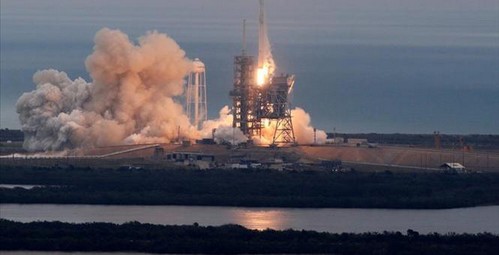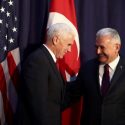Space and American-Russian Diplomacy – Press the Opening
Now that the Trump Administration’s Secretary of State, former Exxon leader Rex Tillerson, has taken his official seat – been duly grilled, confirmed, and sworn in – big things may be about to happen. Like President Trump, Secretary Tillerson is circumspect but hopeful about Russia. One basis for hope, and a platform of cooperation on which both the President and Secretary may be able to expand, is a history of American-Russian cooperation in space.
Specifically, the goal should be to find one or two issues on which the two countries work closely, and use these as a foundation for widening the discussion, as well as reaffirming what exists – which is mutually beneficial.
One such area of cooperation is the transport of American astronauts to and from the International Space Station on the Russian Soyuz rocket. That should continue until the American Atlas V rocket – or some other American rocket – is “man-rated” to carry US astronauts to the Station – and optimally beyond. This example of unbroken cooperation is instructive, and offers hope for others.
A second area of existing, necessary and future cooperation is a longstanding – 20-year – relationship between the two countries on heavy-lift launch. For decades, the two countries have agreeably gotten America’s most important satellites into orbit with the combination of America’s Atlas V rockets and Russian-made RD-180 rocket engines. That relationship has been invaluable to both countries, for strategic, diplomatic, financial and security reasons. While the revenue stream to Russia is modest, Russia knows America has eyes in the sky that assure against any surprises or need for preemptive attack. Russia also knows that there are at least some areas in which the two nations, all else aside, will continue to work together.
At the same time, America has gained invaluable, affordable, reliable, and highly cost-effective RD-180 rocket engines to place priceless satellites in deepest orbits. This relationships steadfastly preserves a critical option for America – the ability to deliver irreplaceable and heavy payloads to outer orbits on Atlas V rockets. The combination and synchronicity has been nearly flawless. Payloads have recently been placed with such accuracy that launch personnel, engineers and scientists have marveled that the combination just seems to keep getting more improbably accurate.

Absent that RD-180 option and smooth American-Russian cooperation in space, America would have only an extraordinarily expensive Delta IV rocket option.
That option is all but cost prohibitive. For the next decade or more, experts believe that an American made option is out reach. The Atlas V with RD-180 is a special and highly effective heavy-lift launch option. Both countries know it – and if the Trump Administration is thinking proactively, they will also use this relationship to extend the diplomatic opening.
Specifically, even as we hope on American-made options in the decades ahead, the magic Atlas V with RD-180 rocket engine combination should be pressed hard. All limits on buys from Russia should be lifted, so that we can achieve three important outcomes: First, get that combination” man-rated” as a new way for American astronauts to travel safely to the space station for NASA; second, preserve indefinitely America’s ability to regularly and reliably put critical satellites into outer orbits with heavy lift – without incident; and three, use both of the foregoing advances to expand the US-Russian diplomatic opening to other areas. If the Trump Administration presses these three aims, the outcome will be good for America, for US-Russian diplomacy, and for world security.
And here is the breaking news: The time may be upon us. Just last month, the Russian ambassador to the United States, speaking at an American Physical Society meeting, indicated – for the first time in years – that “Russia would be open to enhanced cooperation in space should the Trump administration pursue improved relations between the countries.” In an imperfect world, openings for diplomatic advancement come infrequently. This may be one worth acting on.





